In this article, we have provided Rajasthan Board Class 10 Social Science 2015 question paper solutions in pdf format. These Rajasthan Board Class 10 Social Science 2015 Question Papers With Solutions will help students to learn the correct methodology of writing an answer. They can also clear their doubts by referring to the solutions. Students are advised to solve the previous year question papers 2-3 months prior to the exam.
By solving the question papers, students can understand the question paper pattern, marking scheme for each section, etc. The previous year question papers also provide an overview of the real question paper pattern. Referring to these RBSE Class 10 Social Science 2015 Question Paper Solutions will help the students to face the exams more calmly and with confidence.
When it comes to exam preparation, these previous year question papers help students to evaluate their performance and work on their weak points. These solutions are accurately solved by subject professionals after thorough analysis of the topics covered in the syllabus. From the highlighted link below, students can download free pdf of RBSE solutions of Class 10 Social Science 2015.
Rajasthan Board Class 10 Social Science Question Paper 2015 with Answers – Free Download
Download RBSE Board 2015 Social Science Question Paper
Download RBSE Board Social Science Question Paper With Solutions
Rajasthan Board Class 10 Social Science Question Paper With Solution 2015
1. Who was the President of Lahore session of the Congress in 1929.
Answer: Jawaharlal Nehru.
2. Which form of government is accepted throughout the world despite of some shortcomings?
Answer: Democratic Government
3. What is the primary sector?
Answer: Primary sector is known as the agricultural and allied sector services. This sector provides raw materials for goods and services. The primary sector is unorganized and uses traditional techniques. Activities in this sector consist of agriculture, forestry and mining. In most developing nations such as India, this sector is where a large section of the workforce is employed, in comparison to developed nations.
4. What is Bank Cheque?
Answer: A bank cheque is an order in writing drawn upon a bank to pay a specified sum to the bearer or the person named in it. Each cheque book has a counterfoil in which the same detail as entered in the cheque are filled. The counterfoil remains with the account holder for the future reference.
5. What is meant by globalisation?
Answer: The term Globalisation refers to the integration of the economy of the nation with the world economy; it is a multifaceted aspect. It includes the creation of networks and pursuits transforming social, economic and geographical barriers.
6. Which are final goods?
Answer: Final goods are referred to as those goods which do not require further processing. These goods are also known as consumer goods and are produced for the purpose of direct consumption by the end consumer.
7. Clarify the meaning of international resources.
Answer: International resources means the resources which belong to all the countries of the world. International Resources are regulated by some International institutions. For instance, every country is given some rights over the oceans to a specific range.
8. Write any two features of Arid soil.
Answer: Two features of Arid soil are:
- The soil is red and brown in colour.
- It is sandy in texture.
9. Why is conservation of forest & wildlife necessary?
Answer: We should conserve forests and wildlife because they are essential for us in the following terms:
Forests
- Forests provide us with oxygen, they cause rainfall.
- Forest prevents soil erosion.
- Plants are dependent on animals and birds for their pollination and seed dispersal.
- Forests provide us with various medicines.
- Various forest products are used as raw materials in industries.
Wildlife
- They are the consistent element of the nature
- Ecological balance is maintained by this wildlife community
- Some species are extinct and some are on the verge of extinction
- Endangered species must be protected
- Wildlife has the equal rights to stay on this planet
10. In your opinion how is ‘Dam’ useful?
Answer: Dams are important because they provide water for domestic, industry and irrigation purposes. Dams often also provide hydroelectric power production and river navigation. It also helps in preventing floods.
11. Describe the geographical conditions for wheat farming.
Answer: The geographical conditions for wheat farming are:
- Climate- Cool and moist weather during growth, and warm and dry climate during ripening is needed.
- Temperature – An average temperature of 21°C should be maintained.
- Rainfall – 50-75 cm rainfall is required. Rainfall is necessary and beneficial, 15 days after sowing, and 15 days before ripening. A few light winter showers or assured irrigation ensures a good harvest.
- Soil – Light loamy soil is required. It can also be grown in black soil.
12. Name the two rock series of two main geological ages in which coal occurs.
Answer: In India Coal occurs in rock series of two main geographical ages, namely Gondwana, a little over 200 million years in age and in tertiary deposits which are only about 55 million years old. The major resources of Gondwana coal, which are metallurgical coal, are located in Damodar valley (West Bengal-Jharkhand). Jharia, Raniganj, Bokaro are important coalfields.
The Godavari, Mahanadi, Son and Wardha valleys also contain coal deposits. Tertiary coals occur in the north-eastern states of Meghalaya, Assam, Arunachal Pradesh and Nagaland.
13. “Iron and Steel industry could not develop fully in India.” Give any two reasons for this.
Answer: Iron and Steel industry could not develop fully in India because:
- High costs and less availability of coal
- Irregular supply of energy, poor infrastructure and machinery, labour problems, etc.
14. Name the book written by Gandhiji in 1907. Why did he adopt the policy of Non-cooperation against the British to achieve independence?
Answer: Hind Swaraj or Indian Home Rule is the book written by Gandhiji In 1909. He adopted the policy of non-cooperation movement after the Jallianwala Bagh Massacre and death of Bal Gangadhar Tikal. He announced the Non Cooperation Movement in August 1920.
Note : Attempt any two questions from Q. Nos. 15 to 17.
15. Between which two European power blocs was the First World War fought ? How far do you agree with the statement that ‘it was the first modern industrial war’?
Answer: The First World War was fought between two power blocs. On the one side were the Allies – Britain, France and Russia (later joined by the US); and on the opposite side were the Central Powers – Germany, Austria-Hungary and Ottoman Turkey.
The First World War was the first modern industrial war. For the first time, it saw the use of machine guns, tanks, aircraft, chemical weapons etc on a massive scale. During this time, the world experienced economic and political instability.
16. Describe the chawls of Bombay in your own words. From where was this system adopted?
Answer: Chawls were multi-storeyed structures constructed in the native areas of the city of Bombay. It is largely inhabited by migrant workers working in the textile factories of Bombay. They were owned by largely private landlords like bankers, merchants and building contractors looking to earn quick money by exploiting migrant workers. Each chawl was divided into smaller one-room tenements which had no private toilets.
17. State any three impacts of the abundance of labour in the market on the life of labour class.
Answer: Three impacts of the abundance of labour in the market on the life of labour class.
- There was an abundance of workers in the market than the demand. This had an adverse impact on the lives of the workers. Due to the shortage of work, most of the workers failed to get jobs so they offered their services at lower wages.
- Though the wages increased somewhat in the early 19th century, the increase was nullified by increase in price.
- Factory or workshop owners did not house live migrant workers. Many job seekers had to wait weeks, spending nights under bridges or at night in shelters.
18. What steps were taken to make the third tier of Indian democratic system more powerful & effective by amending the Constitution of India?
Answer: Steps taken to make the third tier of Indian democratic system more powerful and effective are:
- Elections are compulsory at regular intervals
- Seats reserved for scheduled castes, tribes and other backward classes
- State election commission for Panchayat
- State government shares power with local government bodies.
19. Is democracy an accountable, responsive and legitimate government? Give reasons in favour of your view.
Answer: Reasons:
- The country is ruled by the person who has been chosen after completion of the voting process through election.
- The rules and regulations to be followed by the ruler as well as citizens are the same. No change in it.
- It is responsive because it takes charge of all the activities which are happening for welfare of the people.
- The right to vote is the most notable feature of our democracy.
- As democracy is based on the constitution, it is considered to be legitimate.
20. In your view, why is the public sector a must ? Write any three points.
Answer: Public sector is a must because:
- The public sector provides many essential things at quite a reasonable cost which the private sector cannot.
- The public sector has the benefit of the people above everything because its purpose is not to earn profits but to benefit the people at all costs.
- The public sector can set up heavy industries, which require a lot of money, but private sectors cannot.
- The public sector is mainly held by the government, which so often bears some of the cost for the benefit of the public, especially for poor people.
21. Give any three suggestions to increase activities of cooperatives in the rural areas.
Answer: Three suggestions to increase activities of cooperatives in the rural areas are:
- To protect the rural people from the high-interest rates charged by the informal sources.
- To create awareness about the formal government sources for loans.
- If the cost of borrowing more, a more portion of income works in repaying loans moderately than investing it.
22. Explain the role of information and communication technology in globalisation on any three bases.
Answer: The role of information and communication technology in globalisation are:
- There have been many improvements in the transport sector which helps in export and import of goods. This increases trade relations between countries.
- Since technology improves efficiency, the process of exchange has become faster and cheaper.
- Development in information and communications technology has been the most beneficial since information can now be sent in seconds across the world.
- Development in IT also has led to the production of services through outsourcing like call centers, online teaching etc.
- Telecommunications have improved contact between people. People living in two different countries can easily be in touch with minimal prices.
23. Why did the consumer movement begin in India? Describe this movement.
Answer: The consumer movement started in India in 1960 and ended in 1970.
There were many factors that gave birth to the consumer movement in India. It started as a social force with the need to protect the consumers against unfair and unethical trade practices being followed by many retailers and manufacturers. These included creating artificial shortages, hoarding cereals and other agricultural products, black marketing of goods and adulteration of cooking oils and food items. Till 1986, consumer organizations were highlighting issues by writing articles in newspapers and magazines about these bad practices of merchants.
But nowadays, as the consumers have become more aware, the number of consumer groups have grown who have highlighted these malpractices. In 1986, the Government of India enacted the Consumer Protection Act, also known as COPRA. This was a major step in the consumer movement in India.
24. What efforts were made by religious movements of the 18th Century for the awareness against the western powers?
OR
Explain the causes of becoming Great Britain as the ‘Ideal Nation State.
Answer: There were many Socio-religious movements in India, to uplift the lives of common Indian people. Raja Ram Mohan Roy who is known as Father of Modern India founded the first religious reform organisation in 1828. He founded Brahmo Samaj. Prarthana Samaj was founded in 1867 by Dr Atmaram Pandurang. Swami Vivekananda is best known for his speech to the 1893 World’s Parliament of Religions in which he introduced Hinduism to America and called for religious tolerance.
Answer: The transformation of Great Britain into a nation state was not a sudden process. There was no British nation before the eighteenth century. People residing in British Isles were mainly English, Welsh and Scots or Irish. These were the ethnic groups with distinct political and social traditions. As the English nation grew in wealth and power, it began to dominate the other islands.
In 1688, the English Parliament seized power from the monarchy. The Parliament passed the Act of Union, 1707, by which England and Scotland were unified resulting into the formation of the ‘United Kingdom of Great Britain’. The Parliament was dominated by the English and the political and cultural identities of the Scots were systematically suppressed. The Catholics in Scotland were brutally suppressed whenever they wanted to regain their independence.
Ireland was inhabited by the Protestants and the Catholics. The English supported the Protestants and established their rule with their help and support. Catholics, who constituted the majority in Ireland, revolted against the British on numerous occasions but were suppressed. Ireland forcibly became a part of Britain in 1801. The English language dominated and both Scotland and Ireland were only subordinate to England.
The idea of nation was expressed in various forms by the artists and the painters. Most of the nations were portrayed as the female figures. The female figure became an allegory of the nation. In France, ‘Marianne’ and ‘Germania’ in Germany became the allegory of a nation.
25. How did print culture influence women in the end of the 19th Century?
OR
What was the contribution of South Indian women in the novel writing?
Answer: The print culture affected women in 19th century in India by the following ways;
- Women became important as readers as well as writers.
- Penny magazines were especially meant for women, as were manuals teaching proper behaviour and housekeeping.
- When novels began to be written in the 19th century, women were seen as important readers.
- Some of the best known novelists had defined a new type of woman; as a person with will, strength of personality, determination and the power to think.
Answer: In South India literacy rate of women is high as compared to other parts of the country. Women of South India are interested in reading and writing which resulted in interest in novel writing. They were very practical and familiar with the problems faced by women. This is the reason they started writing novels related to the problem faced by women and after reading the novels the general women became familiar with their problems and rebelled against the men.
26. What efforts have been made for giving political representation to women in India? Explain.
OR
Explain the role of ‘Caste’ in politics of India.
Answer: Following efforts have been made for giving political representation to women in India.
- The literacy rate of women has been increased.
- Women are provided with some reserved seats in Lok Sabha and the State Assemblies.
- In the elected bodies it is legally binded to have a fair proportion of women.
- Women members should be given due representation in political parties.
Answer: The role of Caste in politics of India are:
(i) While choosing candidates for election, political parties consider the caste composition of the voters to win support.
(ii) When the government is formed, political parties take care that representatives from different castes find place in the government.
(iii) Political parties appeal to the caste sentiments to win votes.
(iv) Some political parties are known to favour some particular caste.
(v) Universal adult franchise and the principle of one-person one-vote have compelled the political leaders to bring caste sentiments into politics to muster support.
27. Explain any four challenges before political parties in India.
OR
Write four policies-programmes of the Bharatiya Janata Party and Indian National Congress.
Answer: Four challenges before political parties in India are:
- Lack of internal democracy within parties. Parties do not keep membership registers, do not hold organisational meetings, and do not conduct internal elections regularly.
- Most political parties do not practice open and transparent procedures for their functioning, so there are very few ways for an ordinary worker to rise to the top in a party. In many parties, the top positions are always controlled by members of one family.
- The third challenge is about the growing role of money and muscle power in parties, especially during elections. Since parties are focused only on winning elections, they tend to use short-cuts to win elections. In some cases, parties support criminals who can win elections.
- People do not find parties to be a meaningful choice for their votes. Sometimes people cannot even elect very different leaders either, because the same set of leaders keep shifting from one party to another.
Answer: Bharatiya Janata Party policies and programmes:
- BJP government policies include extensive privatisation of infrastructure and services.
- The official philosophy of the BJP is “Integral humanism,” a philosophy first formulated by Deendayal Upadhyaya in 1965, who described it as advocating an “indigenous economic model that puts the human being at center stage.
- BJP takes very proactive steps on counter terrorism operations, political will displayed for carrying out major strikes on terror launch pads and terror camps in Myanmar and Pakistan.
- They have focused on many important schemes for alleviating the standard of living of poor people by implementing Direct Benefit Transfer (DBT), Swachh Bharat Mission, Jal Jeevan Mission etc.
Indian National Congress policies and programmes:
- They endorsed a mixed economy, in which both state and private sector play a role in driving economic growth.
- The INC Government had started the National Rural Health Mission to improve the health sector in rural areas.
- The INC government had negotiated the Indo-US nuclear deal, which paved the way for increasing power generation in India through nuclear power and enabling India to carry out trade with countries rich in Uranium reserves.
- To improve the education sector in India, the INC government had started many prestigious colleges and universities in the field of engineering, medicine etc.
28. According to your view which points can be added in redefining democracy?
Answer:
- Complete elimination of all forms of discrimination.
- Social and economic rights are implemented all over the country to each and every citizen.
- Everyone should have the choice to change rulers if they are corrupt through free and fair elections.
- Rulers must implement the solutions to various problems of the people in a time bound manner and make them accountable to the people.
29. In your point of view, which is a much better measure to compare the development between two states on the basis of educational level? Explain.
OR
In your point of view, what should be our goal on sustainability of development ? Explain.
Answer: In my point of view, literacy level is a much better measure to compare the development between two states on the basis of educational level. This is because literacy rate is a key measure of human development. Human development has now become a broader concept of economic development which includes not just per capita income, but also literacy rate and life expectancy.
Answer: Sustainability of development is a new area of knowledge in which social scientists, economists, philosophers and scientists are working together. Some of the pertinent goals would be
- Sustain the development without degrading the environment.
- Sustain the development in such a manner that natural resources are preserved even for our future generations. Example would be crude oil. India does not have sufficient resources of crude oil, hence we are more dependent on exports. Countries like the US also import crude oil, even though they have sufficient reserves. This is done to preserve their crude oil reserves.
- For the development of the agriculture sector, and in rapidly developing urban cities, groundwater is used extensively. Hence we need to focus on development without overusing groundwater.
Scientists have been warning that present levels and types of development are not sustainable, hence we need to be certain about what needs to be done to have sustainable development.
30. Write short notes on the following :
(i) International trade
(ii) Geothermal energy.
Answer i: International trade – International trade is referred to as the exchange or trade of goods and services between different nations. This kind of trade contributes and increases the world economy. The most commonly traded commodities are television sets, clothes, machinery, capital goods, food, and raw material, etc.
International trade has increased exceptionally that includes services such as foreign transportation, travel and tourism, banking, warehousing, communication, advertising, and distribution and advertising. Other equally important developments are the increase in foreign investments and production of foreign goods and services in an international country. This foreign investments and production will help companies to come closer to their international customers and therefore serve them with goods and services at a very low rate. The reasons for International Trade are Production, Factors of Production, Cost of Production and Resources Distribution.
Answer ii: Geothermal energy – Geothermal energy is the thermal energy generated and stored inside the Earth’s crust. The center of the Earth remains at the same temperature as the Sun which is nearly constant due to the continuous process of nuclear fusion. Due to such high temperature and pressure some rocks melt, which results in the upward motion of the mantle (as they become lighter with the heat). These molten rocks formed in the Earth’s crust are pushed upward where they get trapped in certain regions called ‘hot spots’. When underground water comes in contact with the hot spot, steam is generated. Sometimes this hot water formed region finds outlets at the surface. When this hot water gushes out of one of these outlets, it is called hot springs.
31. (a) Mark the following in the given outline map of India:
(i) Bengal
(ii) Punjab.
(b) Mark the following in the given outline map of India:
(i) Jawaharlal Nehru Seaport
(ii) Cotton textile industry-Porbandar
(iii) Woolen textile industry-Bikaner.
Answer a and b: Activity to be done by yourself.
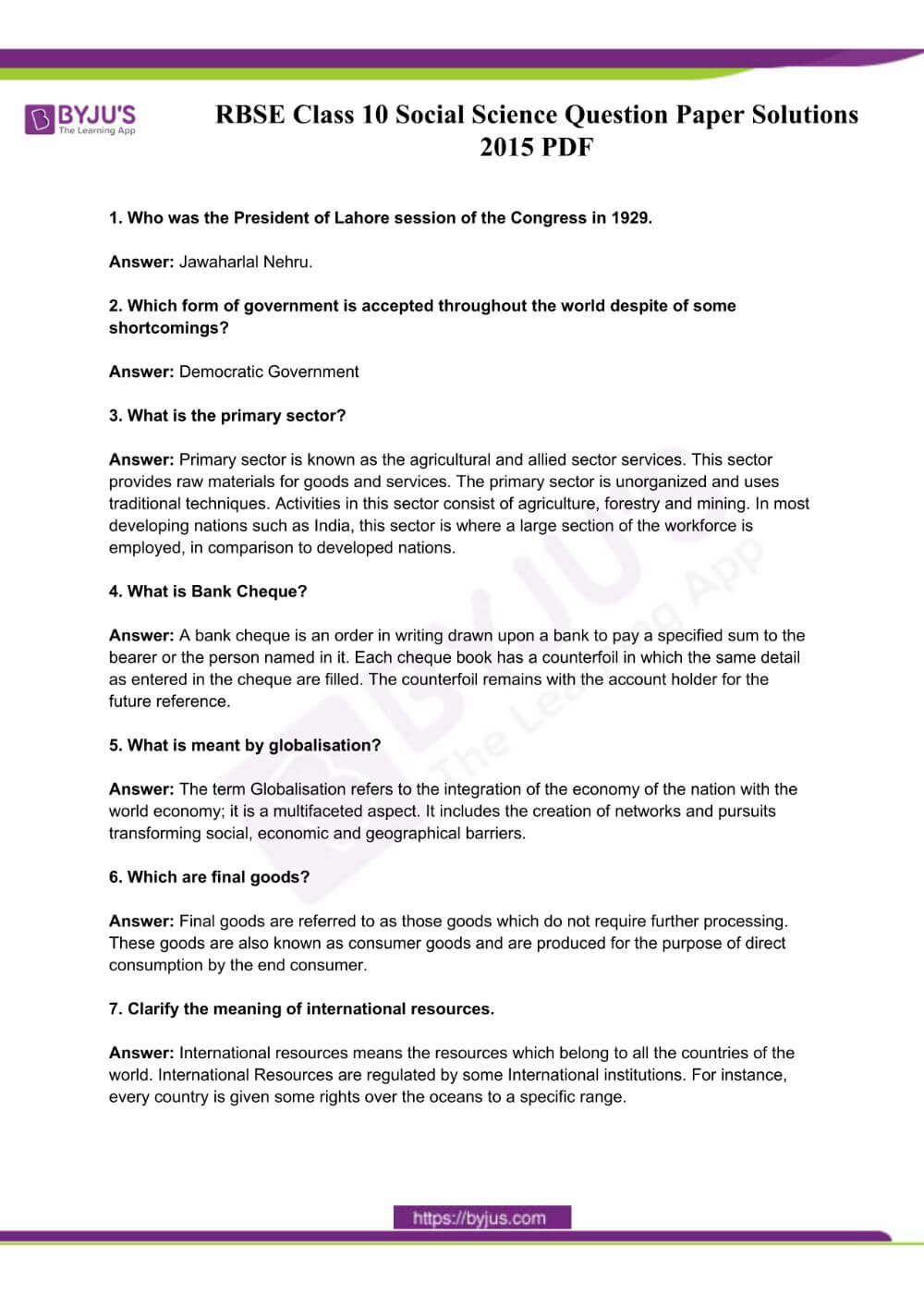
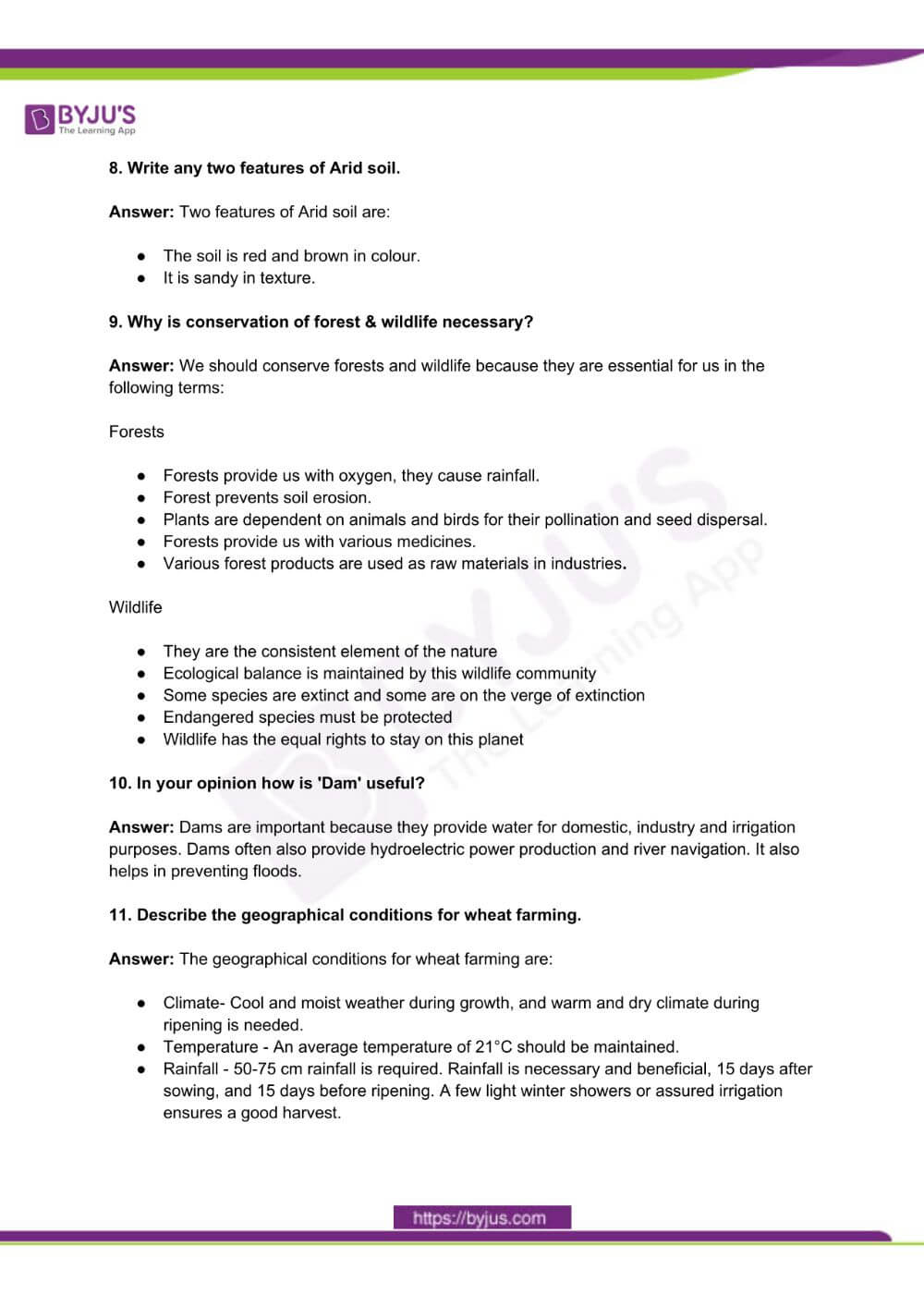
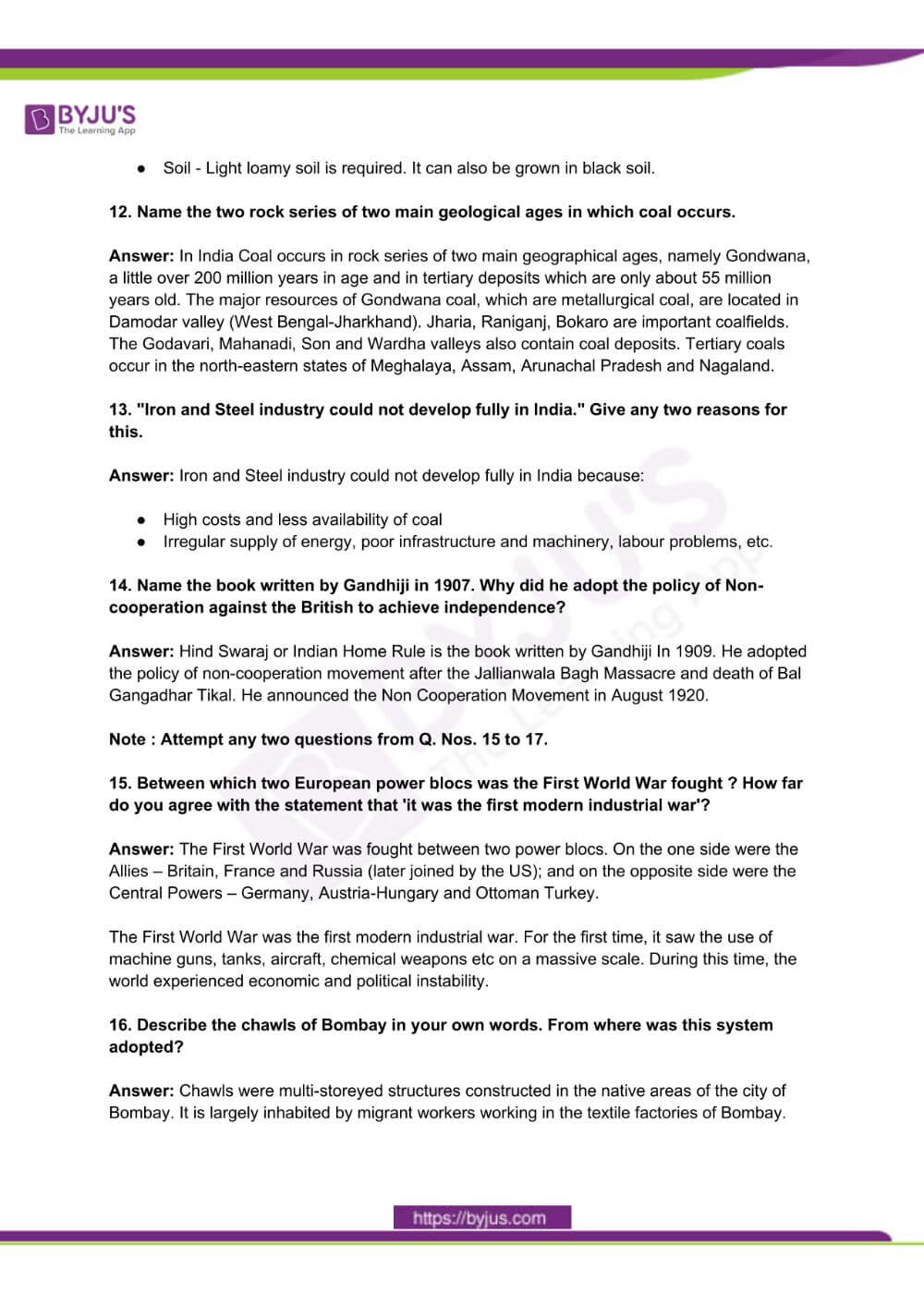
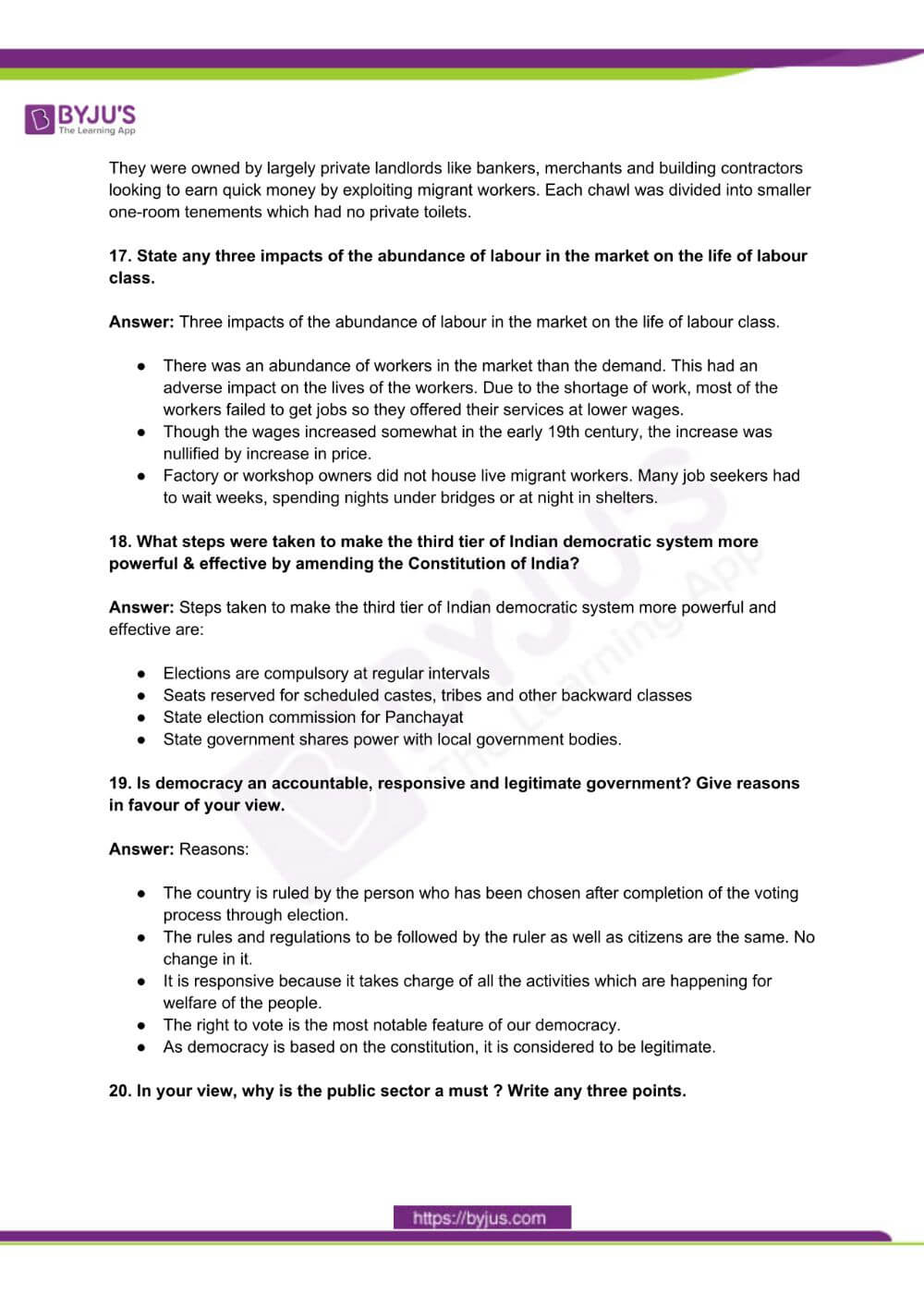
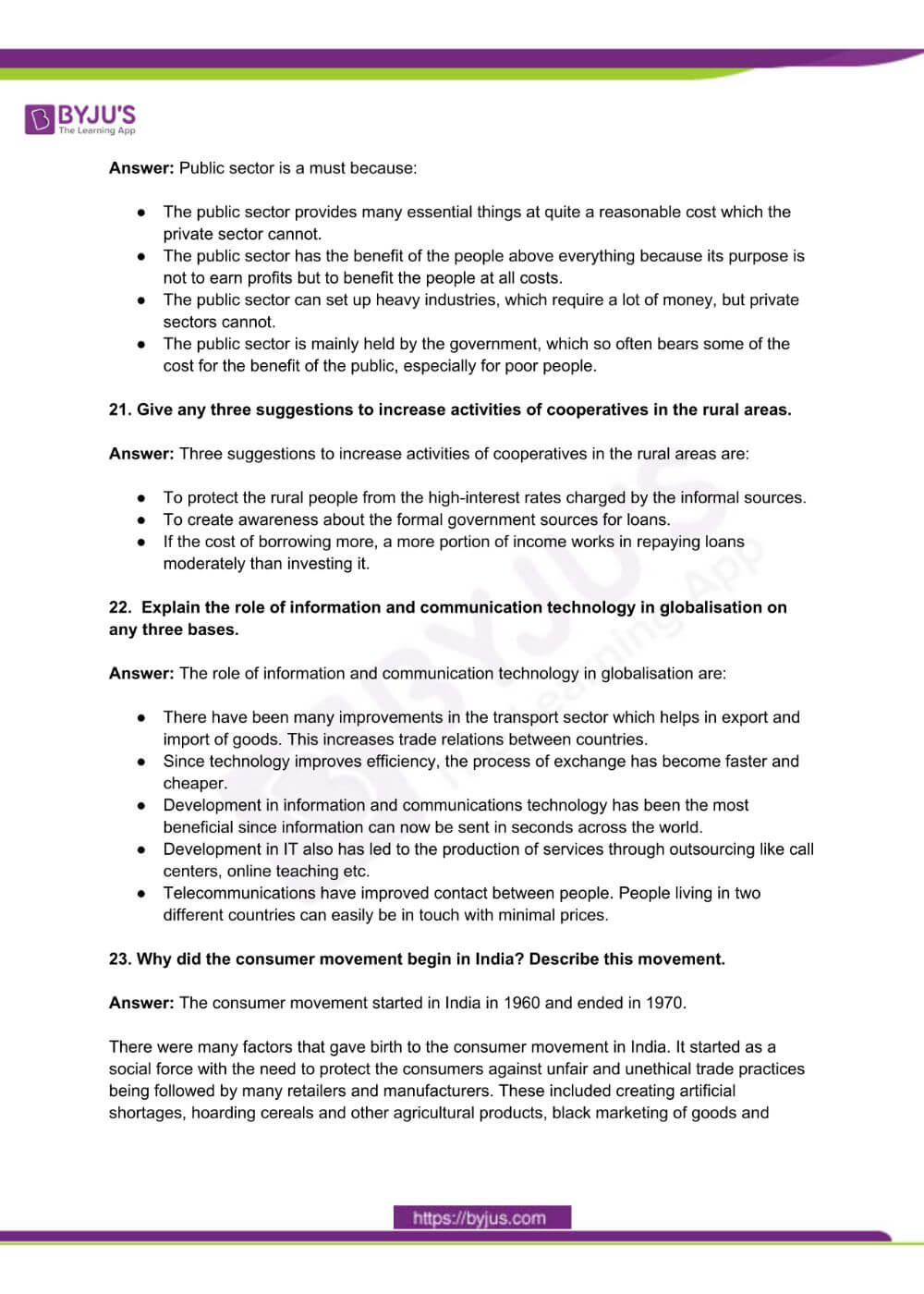

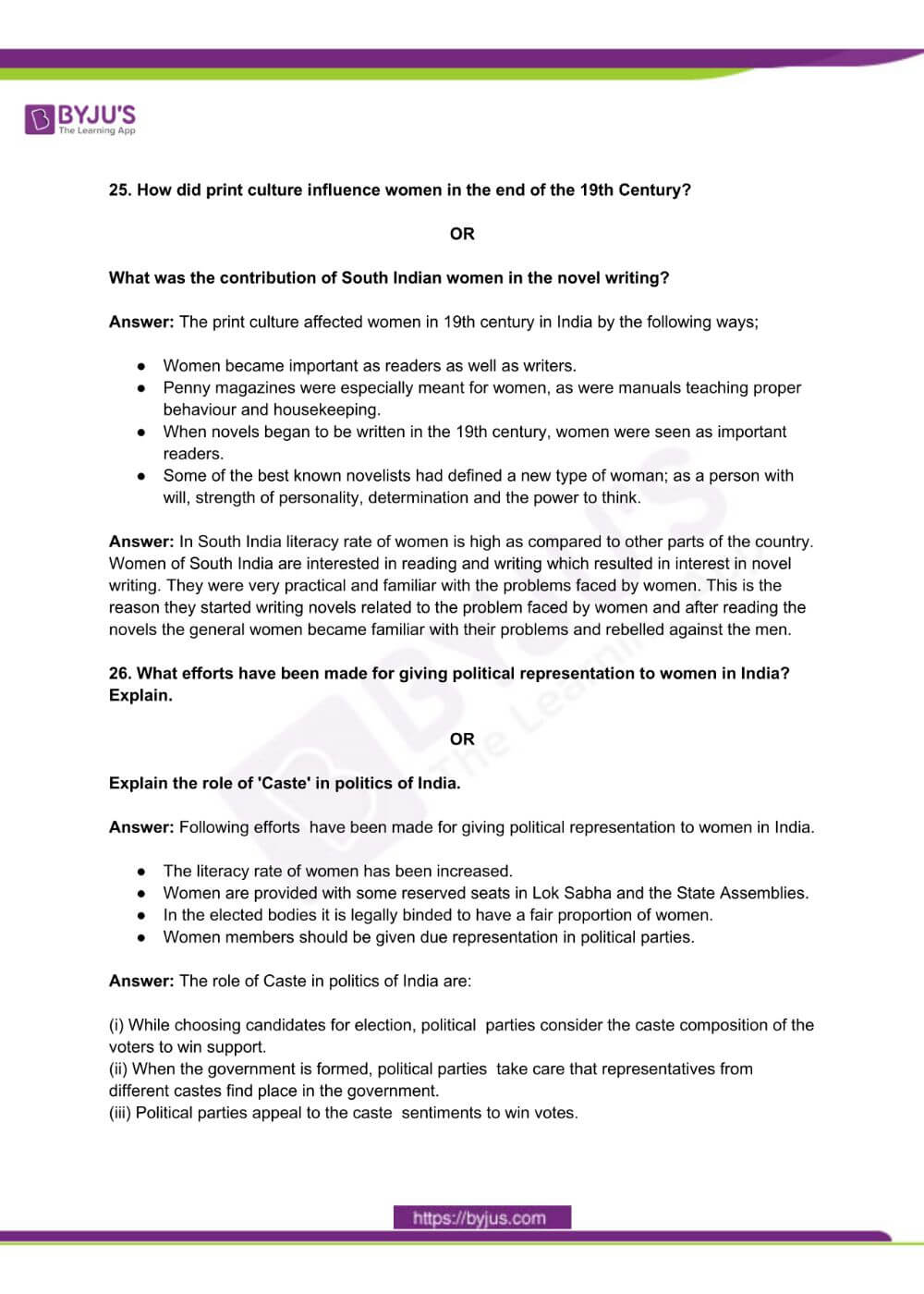
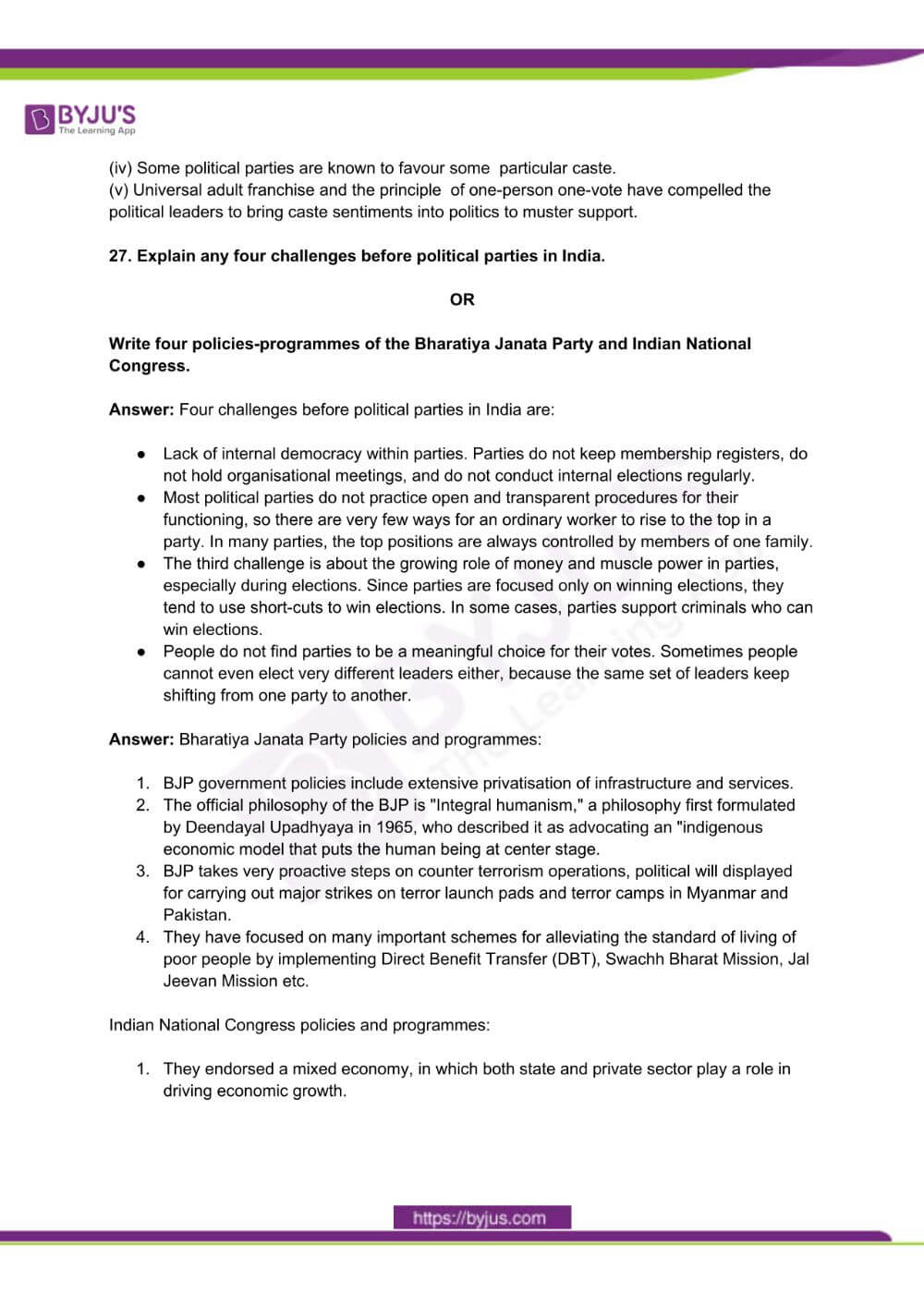
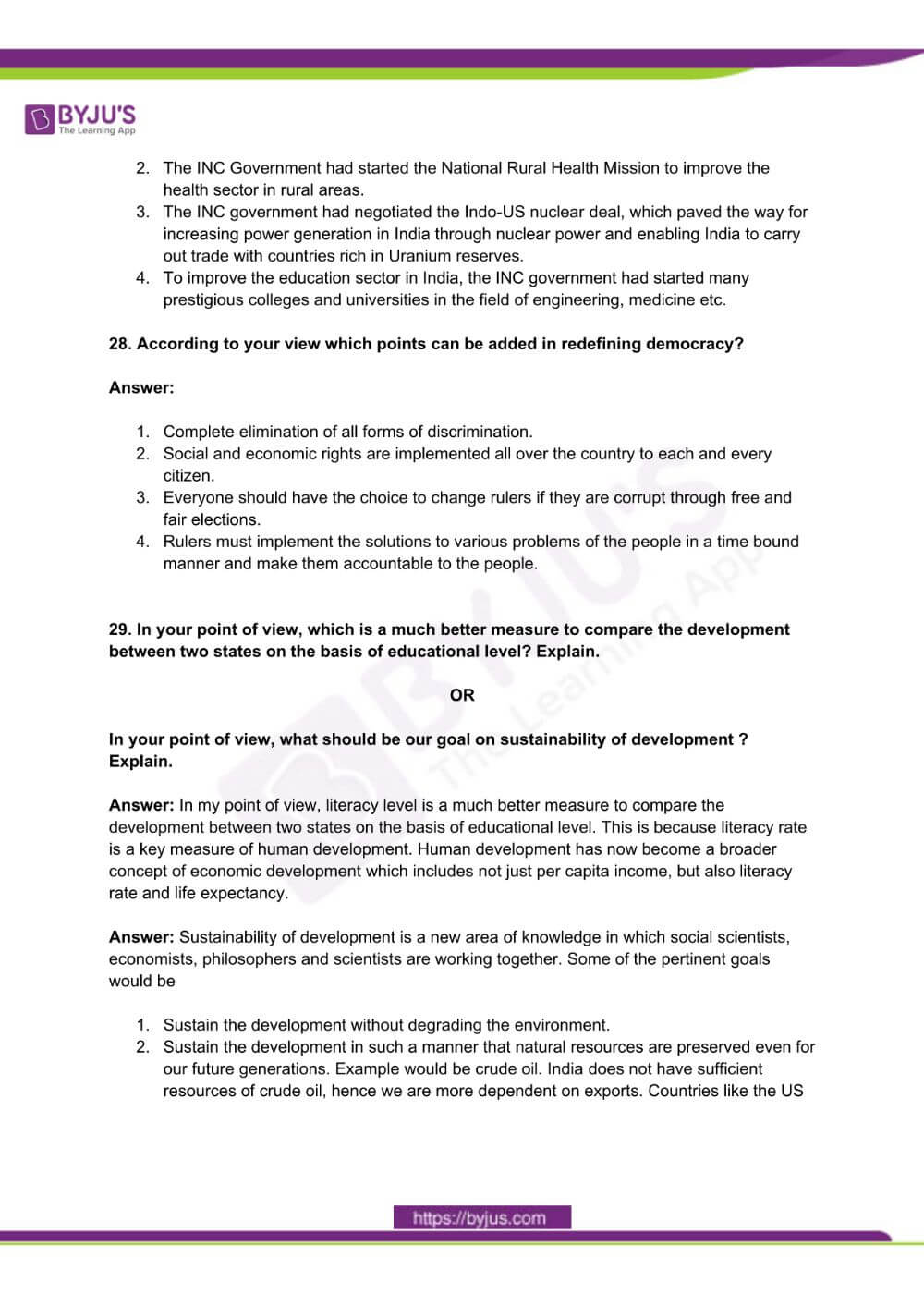
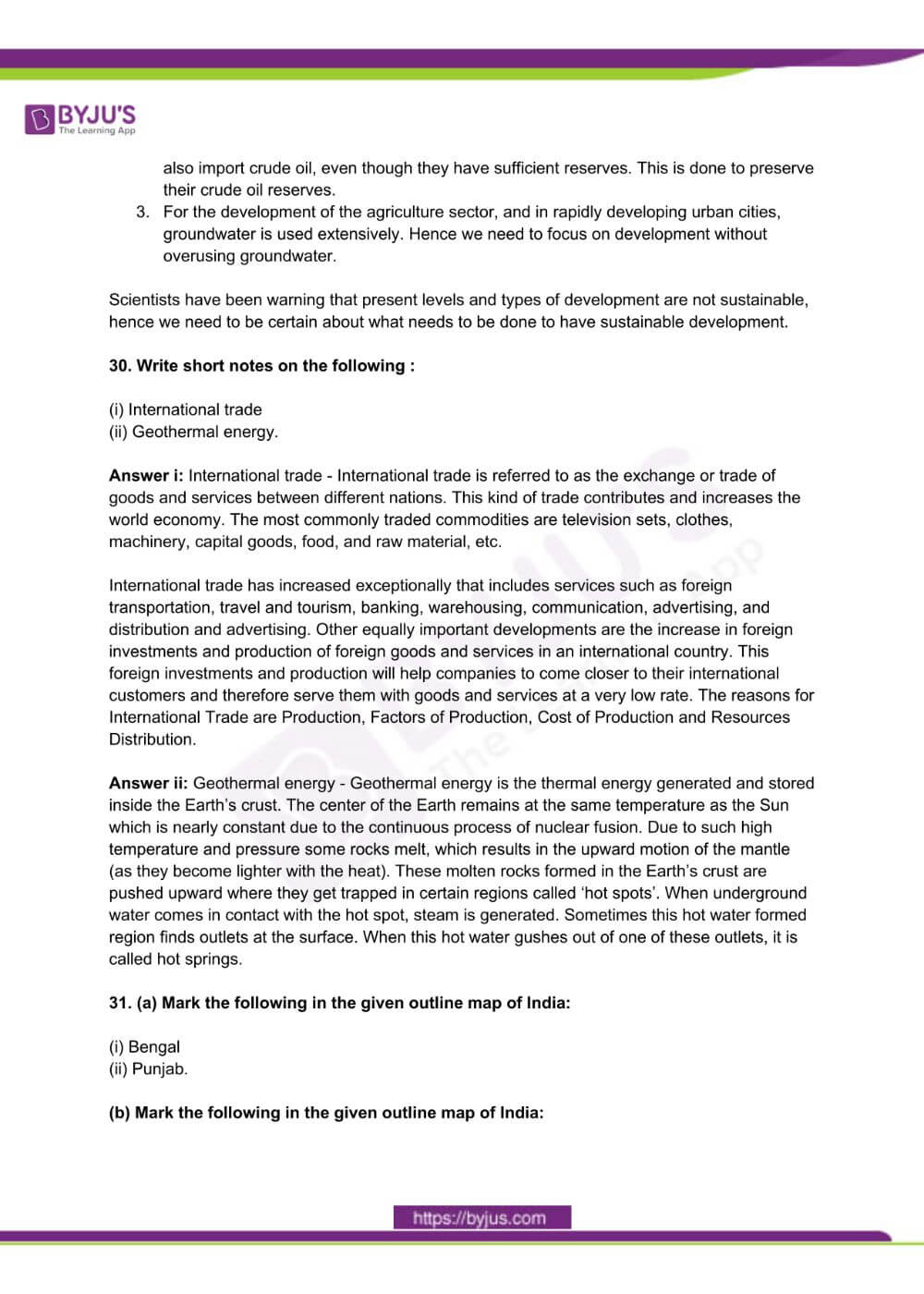
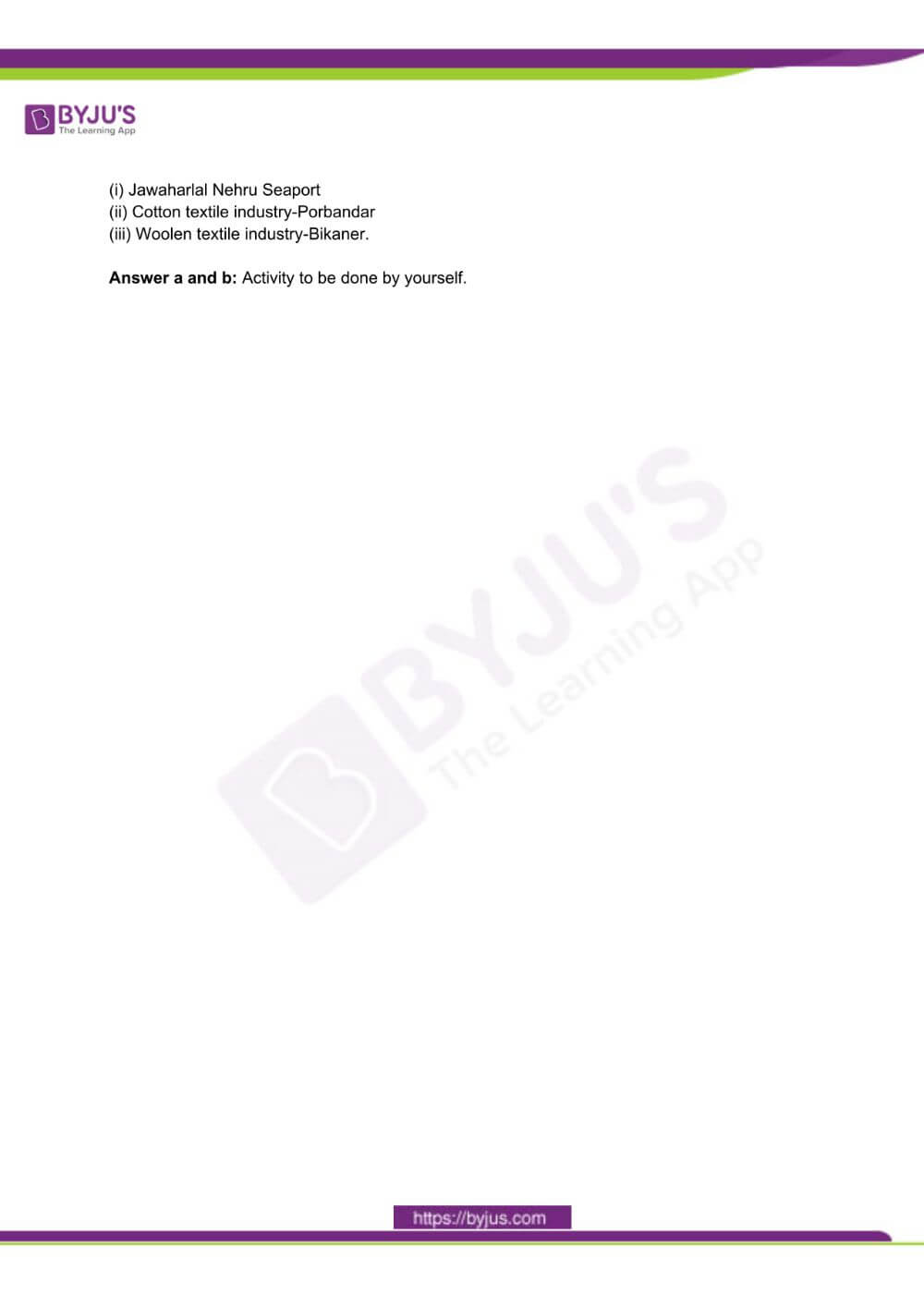
Comments